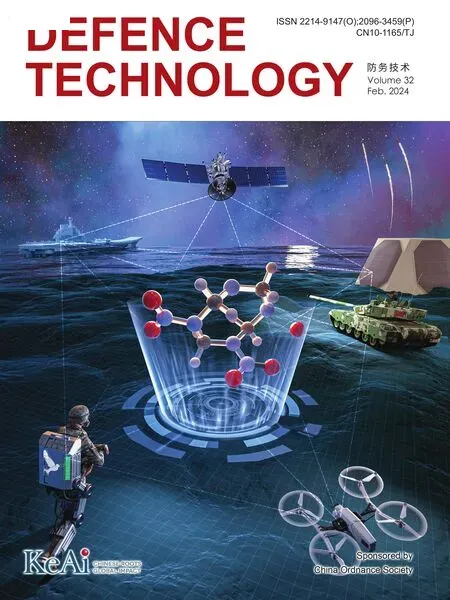New insights in nano-copper chromite catalyzing ultrafine AP:Evaluation of dispersity and mixing uniformity
Yong Kou , Peng Luo , Lei Xio ,*, Ynping Xin , Gungpu Zhng , Yuing Hu ,Junqing Yng , Hongxu Go , Fengqi Zho , Wei Jing , Gzi Ho ,**
a National Special Superfine Powder Engineering Research Center of China, School of Chemistry and Chemical Engineering, Nanjing University of Science and Technology, Nanjing, 210094, China
b Xi'an North Huian Chemical Industry Co.Ltd, Xi'an, 710302, China
c Xi'an Modern Chemistry Research Institute, Xi'an, 710065, China
Keywords:Nano-CuCr2O4 Ultrafine AP Dispersity UV-Vis diffuse reflectance spectroscopy Thermal decomposition
ABSTRACT Improving the application of nanomaterials has always been a research hotspot in the field of energetic materials (EMs) due to their obvious catalytic effect on the EMs, especially the uniformly dispersed nanomaterials.However, few studies have reported the dispersion of nanomaterials.In this study, the dispersity and mixing uniformity of nano-CuCr2O4 was evaluated based on the difference of solid UV light absorption between the nano-catalytic materials and EMs.The nano-CuCr2O4/ultrafine AP composites with different dispersity of nano-CuCr2O4 were prepared by manual grinding and mechanical grinding with different grinding strength and griding time.And then, the absorbance of different samples at 212 nm was obtained by solid UV testing due to the high repeatability of the absorbance at 210-214 nm for three parallel experiments, and the dispersity of different samples was calculated through the established difference equation.Furthermore,the samples were characterized by XRD,IR,SEM,EDS,DSC and TG-MS, which confirmed that different mixing methods did not change the structure of the samples (XRD and IR), and the mixing uniformity improved with the increase of grinding strength and grinding time (SEM and EDS).The scientificity and feasibility of the difference equation were further verified by DSC.The dispersity of nano-CuCr2O4 exhibits a positive intrinsic relationship with its catalytic performance, and the uniformly dispersed nano-CuCr2O4 significantly reduces the thermal decomposition temperature of ultrafine AP from 367.7 to 338.8 °C.The TG-MS patterns show that the dispersed nano-CuCr2O4 advanced the thermal decomposition process of ultrafine AP by about 700 s,especially in the high temperature decomposition stage, and the more concentrated energy release characteristic is beneficial to further enhance the energy performance of AP-based propellants.The above conclusions show that the evaluation method of dispersity based on solid UV curves could provide new ideas for the dispersity characterization of nano-catalytic materials in EMs,which is expected to be widely used in the field of EMs.
1.Introduction
Nanotechnology,as a technology for modifying materials at the nanoscale, has caused tremendous progress in the industrial field[1].The enormous advantages of nanotechnology inevitably give rise to significant developments in the field of energetic materials(EMs) [2,3].Numerous studies show that the application of nanomaterials obviously improved the comprehensive properties of EMs [4,5].Gao prepared the nano-PbO?SnO2composites with an average particle size of 40-60 nm,it demonstrated that 2.5%nano-PbO?SnO2increased the burning rate of the double-base propellant by 1.49 times compared with the blank sample at 4 MPa.In addition, the nano-PbO?SnO2also increases the burning rate of RDXCMDB propellant by 2.55 times at 2 MPa [6].Singh synthesized the Al/Fe2O3nanothermite by a three-step method, and the obtained nanothermite increased the burning rate of HTPB propellant by 2.36 times and advanced the high decomposition temperature of AP by 125°C,showing superior catalytic performance of the nanocatalyst [7].In recent decades, the application of nanomaterials in the field of EMs has been further developed,especially the research and application of nano-combustion catalyst materials, which has greatly promoted the development of EMs [8,9].The nanocombustion catalysts have many excellent characteristics, such as small size effect, surface effect, quantum size effect, macroscopic quantum tunneling effect and various lattice defects,which endow their superior catalytic performance [10,11].
Many literatures have reported that the properties of energetic composites have been greatly improved by nano-combustion catalysts, which shows its broad application prospects in the EMs[12,13].However, we found a fatal flaw of the nano-combustion catalyst in the application, that is, the nano-combustion catalyst has the disadvantage of easy agglomeration, which would greatly reduce the catalytic active sites on its surface so that reduce its catalytic performance.Even, the catalytic performance of the agglomerated nano-combustion catalyst may be lower than that of conventional sized catalytic materials [14].Therefore, solving the problem of easy agglomeration of nano-catalyst materials and improving their dispersity has become an urgent problem to be solved in the field of EMs.
Composite solid propellants(CSPs)are the basis for the modern solid rocket propulsion systems, and they are also the origin of space shuttle boosters and space launch boosters.With the development of science and technology,higher requirements have been put forward for CSPs,such as high burning rate,large thrust,etc.,to improve the capabilities of weapons for precision guidance, longrange strikes, and efficient damage [15].It is well known that the addition of nano-combustion catalysts to CSPs is a most effective method to improve the combustion performance of propellants,which has always been a research hotspot of propellant formulations due to its distinctive characteristics of increasing the burning rate, reducing the combustion pressure index, and improving the ballistic performance of the propellant [16].Ammonium perchlorate (AP) is the most widely used oxidant in CSPs, and its oxygen balance reaches+34.04%,implying its strong oxidation capacity in propellants.And the higher hydrogen content of AP also contributes to improve its energy conversion efficiency.In addition,AP has many excellent properties such as low sensitivity,good thermal and chemical stability, and no solid residue after thermal decomposition,and it has been widely used in CSPs with the high proportion of 60%-90%.It is of great importance to study the thermal decomposition properties of AP, which directly affects the performance of CSPs [17-21].Many experiments show that the use of ultrafine AP instead of coarse-grained AP effectively improves the performance of the propellants.However, the use of ultrafine AP alone has been unable to meet the higher requirements for propellants, and it is necessary to add various nano-catalysts to improve their performance.Until now, many researchers have focused their research on the issues of particle size, morphology and type of catalytic materials,and have conducted a lot of research with excellent catalytic effects.However, only a few people have paid attention to the intrinsic regulation of nanomaterials dispersion and their catalytic performance, even though the easy agglomeration characteristics of nanomaterials are understood[22-25].Unfortunately, both ultrafine AP and nano-catalysts all have the defect of easy agglomeration due to their nanoscale effects,which severely limits their excellent performance.Nowadays,multiple ways have been proposed to improve the dispersity of nanomaterials to promote the performance of EMs, such as mechanical ball milling and spray drying [26-31].However, the characterization of dispersity is still a big problem at present.There are also scanning electron microscope(SEM),transmission electron microscope(TEM),X-ray diffractometer(XRD)and specific surface area test (BET) to characterize the dispersity of nanomaterials, but the above methods are all have some limitations.For example,SEM and TEM analysis of nanomaterial dispersion is susceptible to human factors,while XRD and BET may not detect gaps when catalyst content is low [10-12].They are also unable to quantitatively analyze the catalytic performance of nano-catalytic materials with different dispersity.The above problems have led to the bottlenecks in the research on dispersity at home and abroad.In response to the current predicament, our research group proposed a new method to characterize the dispersity of nano-catalytic materials, namely UV-Vis diffuse reflectance technology.It is an important method for the spectroscopic analysis of nanomaterials with characteristics of easy operation, high sensitivity and good accuracy.It can also accurately detect the spectroscopic characteristics of nanomaterials under visible and UV light irradiation, such as the qualitative and quantitative determination of most metals and non-metallic substances [32,33].It is well known that improving the dispersion of nano-catalytic materials could improve their catalytic performance,which can be demonstrated by the thermal decomposition properties of AP.Thus,the thermal analysis technique(TG-DSC)will be used as an aid to explore the accuracy of using solid UV to probe the dispersion of nano-catalytic materials in ultrafine AP, as the DSC tool allows accurate calculation of thermodynamic and kinetic parameters during the thermal decomposition of the composites[34,35].
Nowadays,several types of catalysts have been used to improve the thermal decomposition performance of AP, such as various carbon materials[36],transition metals and transition metal oxides[18], and single-atom catalysts [37], etc.However, all the above catalytic materials have some limitations in facilitating thermal decomposition of AP.For example, carbon materials are mostly used as carriers to improve the dispersion of nanomaterials,and the catalytic ability of transition metals and transition metal oxides is slightly weaker than that of composite metal oxides.Single-atom catalysts exhibit excellent catalytic performance, but they cannot be applied to propellants at present due to the difficulty of preparation in large quantities.The composite metal oxides, as commonly used nano-catalytic materials in propellants, have overcome the above-mentioned shortcomings.Furthermore,it has exhibited better physical and chemical properties than monometallic oxides due to their unique crystal structures.For example,the lattice of composite metal oxides contains a large number of defects that are capable of forming a large number of vacancies to serve as active sites for catalytic reactions.Moreover, the different catalysts in the composite metal oxides have obvious catalytic effects on AP, which can realize the synergistic catalytic effect of bimetals, thus showing the unique advantages of the composite metal oxides.The CuCr2O4with spinel structure is a typical representative of composite metal oxides, which has shown excellent catalytic effect on AP, especially the nano-CuCr2O4[38-41].In this study, the dispersity of nano-CuCr2O4in ultrafine AP was taken as an example to qualitatively and quantitatively analyze the dispersity of nano-CuCr2O4, and the internal correlation mechanism between the dispersion uniformity and catalytic performance of nano-catalytic materials was also explored, which is expected to provide new ideas for the future research.
2.Experimental section
2.1.Materials
Nano-CuCr2O4(d50= 30 nm) was prepared by mechanical grinding(The nano-CuCr2O4with good dispersion was obtained in HLG-5 nano pulverizer with water and a small amount of ethanol as the dispersion medium and the rotational speed of the cylinder was 1200 r/min.).Ultrafine AP (d50= 1.9 μm) was prepared using jet milling method.Ethyl acetate (C4H8O2, AR) was purchased from Sinopharm Chemical Reagent Co., Ltd.Deionized water (AR) was obtained from Nanjing Chemical Reagent Co.,Ltd.The purity of the products was certified by the supplier,and the materials were used without further purification.
2.2.Preparation of the different nano-CuCr2O4/ultrafine AP composites
2.2.1.Preparation of different nano-CuCr2O4/ultrafine AP composites by manual grinding
First, put 0.98 g ultrafine AP and 0.02 g nano-CuCr2O4in a mortar (ultrafine AP: nano-CuCr2O4= 98:2), and 2 ml of ethyl acetate was added.Then,nano-CuCr2O4/ultrafine AP composites with different dispersion of nano-CuCr2O4were prepared by controlling different grinding strength (stirring, light grinding, medium grinding and vigorous grinding)and grinding time(5 min,10 min,30 min and 60 min).Finally, the nano-CuCr2O4/ultrafine AP composites were obtained by drying the samples in a water bath oven at 50°C.Notably, the four grinding forces of stirring, light grinding,medium grinding and vigorous grinding are defined by the strength in the preparation process.Stirring was carried out with a spoon,and no force was applied.The light stirring, medium grinding and vigorous grinding were carried out with agate sticks,and the force ratio was about 1:2:6,which was mainly controlled by humans and try to ensure the different dispersity of the samples.The different nano-CuCr2O4/ultrafine AP composites prepared by manual grinding are shown in Table 1.The method of the composites prepared by manual grinding is shown in Fig.S1.
2.2.2.Preparation of different nano-CuCr2O4/ultrafine AP composites by mechanical grinding
The different nano-CuCr2O4/ultrafine AP composites prepared by manual grinding could be used to investigate the dispersion of nano-CuCr2O4in ultrafine AP.However, there are still some limitations in manual grinding,and the nano-CuCr2O4and ultrafine AP cannot be uniformly dispersed in the composites, which makes it impossible to systematically explore the dispersity of nano-CuCr2O4in ultrafine AP.It is necessary to prepare the uniformly dispersed nano-CuCr2O4/ultrafine AP composites with mechanical milling for research.The preparation of CuCr2O4/ultrafine AP composites was carried out using the grinder of 01-HD.(It is worth noting that the standardization of operation needs to be noticed,although the liquid phase environment could improve the safety of the experiments.)
Experiment process: First, put 19.6 g ultrafine AP and 0.4 g nano-CuCr2O4into the grinding jar (ultrafine AP: nano-CuCr2O4= 98:2).Second, add an appropriate amount of zirconia beads and 300 ml ethyl acetate into it.It is worth noting that the height of ethyl acetate needs to exceed that of the samples.Then,set the rotation speed to 1000 r/min,and the samples with different dispersity were prepared by controlling different mechanical grinding times (30 min and 3 h).The composite with 5 wt% nano-CuCr2O4was also prepared by the above method to investigate the effect of nano-CuCr2O4content on the solid UV curves.The samples of nano-CuCr2O4/ultrafine AP composites with different dispersity prepared by mechanical grinding are shown in Table 2.And the preparation process of the composites prepared by mechanical grinding is shown in Fig.S2.
2.3.Theoretical basis for the dispersity of nano-CuCr2O4 in ultrafine AP
The UV-Vis diffuse reflectance spectrum is tested with an integrating sphere accessory, which could collect all diffuse reflected light.A particularly important factor for investigating dispersity with UV-Vis spectroscopy is that the different substances have different absorptions of UV light.For example, the comparative sample BaSO4hardly absorbs UV light, nano-CuCr2O4has a greater response to UV absorption,while ultrafine AP has a smaller absorption response to UV light, which clearly confirms the different responses of different substances to UV light.It was also found that the better dispersity of nano-CuCr2O4in nano-CuCr2O4/ultrafine AP composites, the higher UV absorption of the composites.The relevant introduction of solid UV is shown in Fig.S3.
2.4.Characterization
The UV-Vis diffuse reflectance spectroscopy was conducted on UV-2600,and three parallel experiments were performed for each sample to improve the accuracy.The particle size and particle size distribution of ultrafine AP were determined by Mastersizer 2000 particle size analyzer (wet method, Tween-80 was selected as dispersant).The crystal forms of the samples were determined using an Advanced D8 X-ray diffractometer(XRD).The particle size of the samples can be estimated according to the Scherrer formula(Eq.(1)).
where D is the particle size; B is the diffraction peak width at half maximum(rad);λ is the incident X-ray wavelength(0.15406 nm);θ is the diffraction angle (°).
The IR spectrum was obtained on an infrared spectrometer(Thermo Fisher Scientific).The morphology of the samples was characterized by S-4800II/SU8010 scanning electron microscope.The thermal decomposition properties of the samples were analyzed by SDT Q600 thermogravimetric and differential scanning calorimeter simultaneous analyzers(The heating rate is 20°C/min;the N2gas flow rate is 20 mL/min).Thermogravimetric-mass spectrometric analysis was performed using METTLER Mettle-Toledo TGA-DSC 1-1600 LF-PTM90611234.

Table 1 Different nano-CuCr2O4/ultrafine AP composites prepared by manual grinding (2 wt%).

Table 2 Different nano-CuCr2O4/ultrafine AP composites prepared by mechanical grinding.
3.Results and discussion
3.1.Morphology and structure of ultrafine AP and nano-CuCr2O4
The crystal structure of ultrafine AP and nano-CuCr2O4were explored using XRD, and the results are shown in Fig.1.As displayed in Fig.1(a), the ultrafine AP exhibits obvious characteristic peaks at 2θ of 15.3°, 19.3°, 22.6°, 23.9°, 24.6°, 25.8°, 27.4°, 30.1°,30.8°, 34.5°, 38.5°, 41.2°, 49.7°and 54.2°, corresponding to the crystal planes of(101),(011),(201),(002),(210),(102),(211),(112),(202),(121),(221),(203),(313)and(214).The positions of the above characteristic peaks are consistent with the standard PDF card(PDF: 43-0648), indicating that the crystal form of ultrafine AP is orthorhombic.Apparently, the ultrafine AP has a high intensity of diffraction peaks,which confirms the smaller particle size of it[4].Fig.1(b)shows that the characteristic peaks of nano-CuCr2O4at 2θ are 29.57°, 31.06°, 35.16°, 37.69°, 46.63°, 53.42°, 56.17°, 61.42°,64.79°, 74.37°, corresponding to the crystal planes of (200), (112),(211), (202), (301), (312), (321), (400), (411) and (422).It also deduces that the nano-CuCr2O4is pure tetrahedron type, as its characteristic peaks are consistent with the standard PDF card (PDF:34-0424).The particle size of the nano-CuCr2O4can be estimated as 18.3 nm from the Scherrer formula (Eq.(1)) based on the halfpeak width of the (211) crystal plane in XRD pattern.Gou's research found that the diffraction peaks of CuO and Cr2O3appeared in the XRD spectrum of the crude CuCr2O4,indicating that there were a few impurities in the crude CuCr2O4[10].Fortunately,the diffraction peaks of impurities(CuO and Cr2O3)in the prepared nano-CuCr2O4are significantly reduced,which can be explained as the fact that the high-speed collision between the grinding beads,grinding jar wall and CuCr2O4can promote the formation of CuCr2O4from free CuO and Cr2O3due to the use of mechanical grinding, which improves the purity of nano-CuCr2O4.However, it is undeniable that small amounts of CuO and Cr2O3are still present in nano-CuCr2O4,even though the nanosizing process can improve the purity of nano-CuCr2O4[42-45].
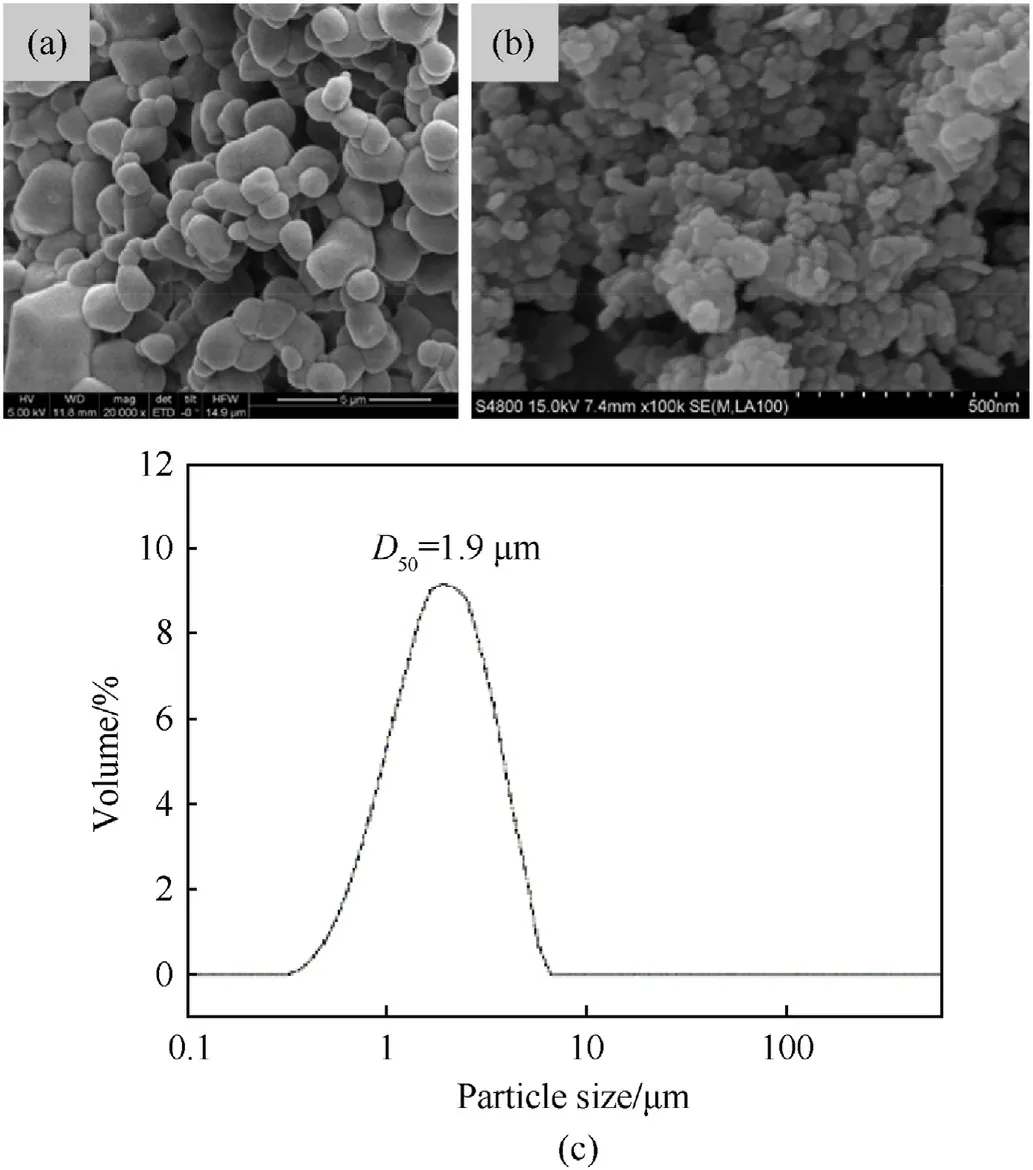
Fig.2.SEM images and particle size distribution of the samples: (a) Ultrafine AP; (b)Nano-CuCr2O4;(c) particle size distribution of ultrafine AP.
The micromorphology of ultrafine AP and nano-CuCr2O4was observed using SEM,and the results are displayed in Fig.2.As can be seen in Fig.2(a), the ultrafine AP obtained by the jet pulverization method has the characteristics of small particle size, smooth spherical shape, and uniform particle size distribution, and the particles also have no obvious defects.As can be observed in Fig.2(b),the particle size of nano-CuCr2O4prepared by mechanical grinding is uniform, with an average particle size of about 30 nm,which is basically consistent with the results of XRD.However,there is a little agglomeration of nano-CuCr2O4particles, which is related to its small size.An important reason is that nano-CuCr2O4relies on agglomeration to reduce the high surface energy of nanoparticles, which greatly affects its catalytic performance.A satisfactory phenomenon is that mixing nano-CuCr2O4with ultrafine AP can simultaneously reduce the surface energy of both them and improve their dispersion, so as to improve the catalytic performance of nano-CuCr2O4[11,46,47].
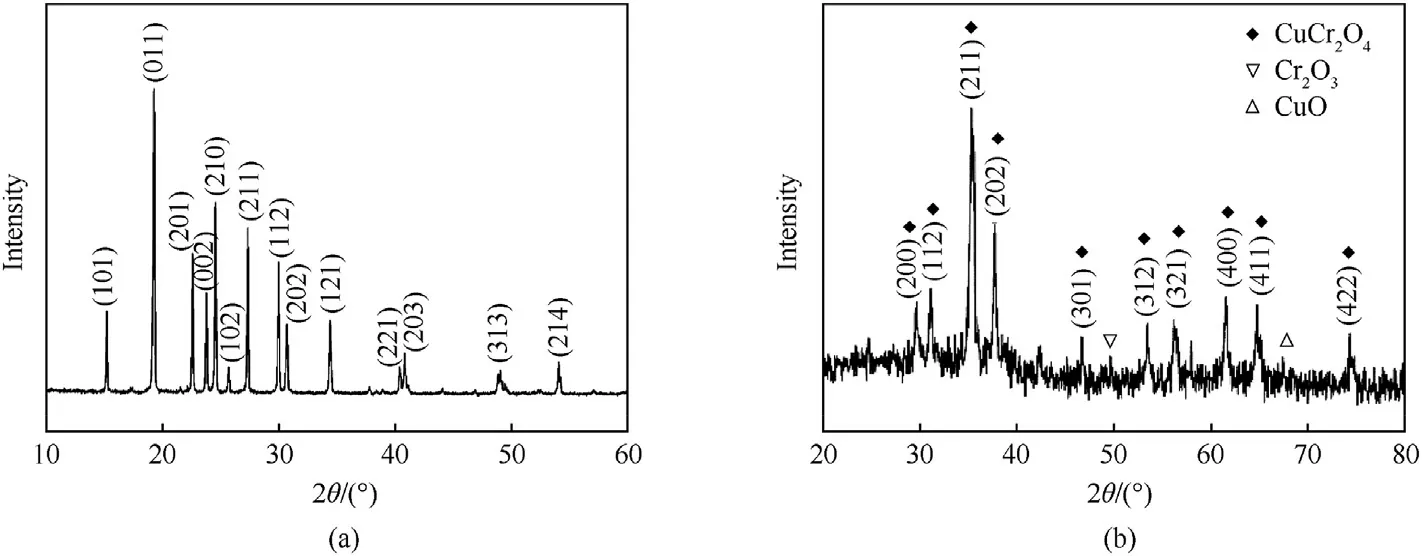
Fig.1.XRD patterns of the samples: (a) Ultrafine AP; (b) Nano-CuCr2O4.
The thermal decomposition properties of ultrafine AP were analyzed, and its TG-DSC curves are shown in Fig.3.Fig.3 shows that the thermal decomposition of ultrafine AP is divided into three stages.The endothermic peak at 250°C is the transition peak of ultrafine AP from orthorhombic to cubic.The exothermic peak at 321.1°C is the low temperature decomposition (LTD) peak of ultrafine AP, and a part of AP is decomposed into intermediate products at this stage.The high temperature decomposition(HTD)peak of ultrafine AP appears at 436.9°C with the increase of temperature.This stage is the gas-phase reaction process of ultrafine AP,which is completely decomposed into gas-phase products.The TG curve also shows that the ultrafine AP has two weight loss stages during thermal decomposition.The weight loss of ultrafine AP is about 15% in the LTD stage, and about 85% in the HTD stage.This study mainly explores the effect of nano-CuCr2O4with different dispersion on the thermal decomposition of ultrafine AP, so the thermal decomposition of nano-CuCr2O4is not separately investigated here[9-11,30].
3.2.Qualitative and quantitative analysis of nano-CuCr2O4 dispersity in ultrafine AP
3.2.1.Solid UV curves of different nano-CuCr2O4/ultrafine AP composites
Solid UV-Vis diffuse reflectance spectroscopy was performed on ultrafine AP, nano-CuCr2O4and nano-CuCr2O4/ultrafine AP composites containing 2 wt% nano-CuCr2O4, and the solid UV curves of samples are shown in Fig.4.As can be observed in Fig.4,the results of three repeated experiments have good repeatability in the near ultraviolet region (210-220 nm).Especially, the three curves of the same sample have the highest coincidence of ultraviolet rays at 210-214 nm,so the absorbance at λ=212 nm can be selected to characterize the relationship between the dispersion of nano-CuCr2O4in ultrafine AP and its UV curves.
3.2.2.Qualitative and quantitative analysis of nano-CuCr2O4dispersity

Fig.3.TG-DSC curves of ultrafine AP.
3.2.2.1.Qualitative analysis of nano-CuCr2O4dispersity at the same content(2 wt%).Three parallel experiments were carried out on the composites with different dispersity of nano-CuCr2O4, as well as ultrafine AP and nano-CuCr2O4.The UV curves were obtained by averaging the three experimental data,and the results are shown in Fig.5.As displayed in Fig.5,the UV curves of different samples are very different in the near UV region, but the UV curves of nano-CuCr2O4/ultrafine AP composites with different dispersion are between the that of ultrafine AP and nano-CuCr2O4.In addition, the UV curves of different nano-CuCr2O4/ultrafine AP composites contain the characteristic UV curves of nano-CuCr2O4and ultrafine AP, indicating the formation of nano-CuCr2O4/ultrafine AP composites.The above phenomenon also shows that it is feasible to explore the dispersity of nano-CuCr2O4in ultrafine AP by using the difference of UV curves.Notably, the UV absorbance of different composites improved with the increase of grinding strength and grinding time at the wavelength (λ) of 212 nm.The characteristics of UV curve in the composite at maximum grinding force and the longest grinding time are closer to that of nano-CuCr2O4,indicating that the dispersity of nano-CuCr2O4is significantly improved.For example,the UV curve of the CuCr2O4-S9 is closest to that of nano-CuCr2O4, which indicates that its dispersity is basically homogeneous and can be used as reference data for the next quantitative analysis.
Taking ultrafine AP, nano-CuCr2O4and composites with different dispersity of nano-CuCr2O4as research objects, the dispersity of nano-CuCr2O4in ultrafine AP was quantitatively analyzed,and the calculation formula of dispersity was established by numerical fitting.Here,the dispersion uniformity is defined as a ratio, that is, the ratio of the difference between the solid UV absorbance of the composite and the ultrafine AP (under different conditions) to the difference of the solid UV absorbance of the composite and the ultrafine AP when uniformly mixed(mechanical grinding for 3 h),which is shown as Eq.(2).
where yiis the dispersion uniformity of nano-CuCr2O4in ultrafine AP; x is the solid UV absorbance of the nano-CuCr2O4/ultrafine AP composite,(a.u);a is the solid UV absorbance of ultrafine AP,(a.u);c is the solid UV absorbance of the nano-CuCr2O4/ultrafine AP composite under the condition of mechanical grinding for 3 h,(a.u).The absorbance used in the above equation is the average value of the absorbance in three parallel experiments.
It can be considered that the dispersity of nano-CuCr2O4in ultrafine AP is 0 when the ultrafine AP does not contain nano-CuCr2O4.Meanwhile,it is believed that nano-CuCr2O4has the best dispersity in ultrafine AP when mechanically milled for 3 h,and its dispersity is 1.And then, the dispersity of composites can be quantitatively analyzed by substituting the absorbance of different composites into Eq.(2).In the follow-up test,the absorbance of the composite containing 2 wt%nano-CuCr2O4prepared by mechanical ball milling for 30 min would be brought into Eq.(2)for verification to further improve the reliability of the established method of dispersity characterization.
3.2.2.2.Quantitative analysis of nano-CuCr2O4dispersity at the same content (2 wt%).The absorbance of different samples at the wavelength of 212 nm was introduced into Eq.(2),and then the defined dispersion uniformity can be obtained, so that we could quantitatively analyze the dispersion of nano-CuCr2O4in ultrafine AP.The dispersity of different samples is shown in Table 3.As displayed in Table 3,the absorbance of the samples increased with the increase of grinding strength and grinding time, and the calculated dispersity of nano-CuCr2O4in ultrafine AP also improved gradually.The results of quantitative analysis are consistent with that of qualitative analysis, indicating the feasibility of the established dispersity analysis method.
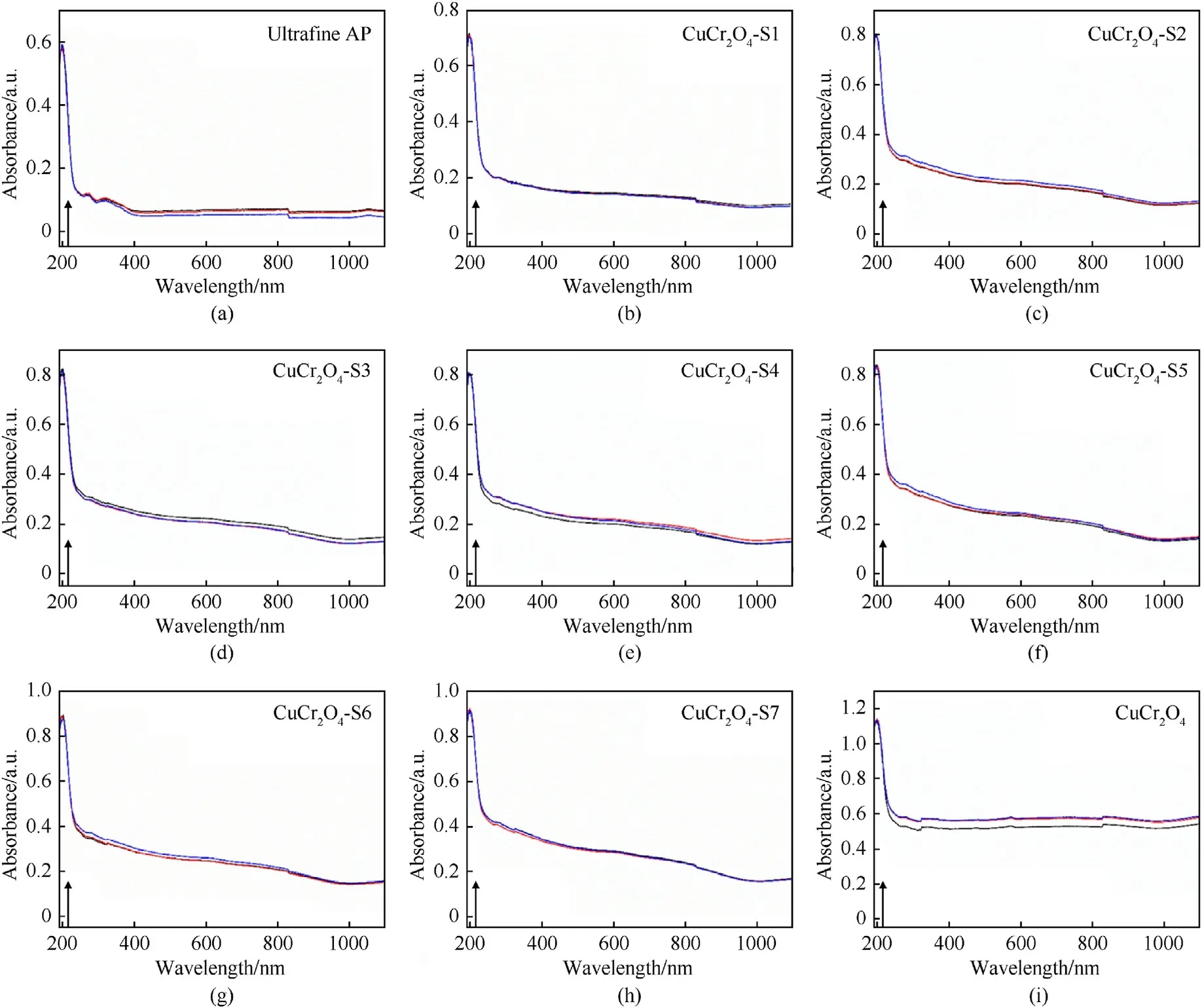
Fig.4.UV curves of ultrafine AP, nano-CuCr2O4 and different nano-CuCr2O4/ultrafine AP composites (containing 2 wt% nano-CuCr2O4).
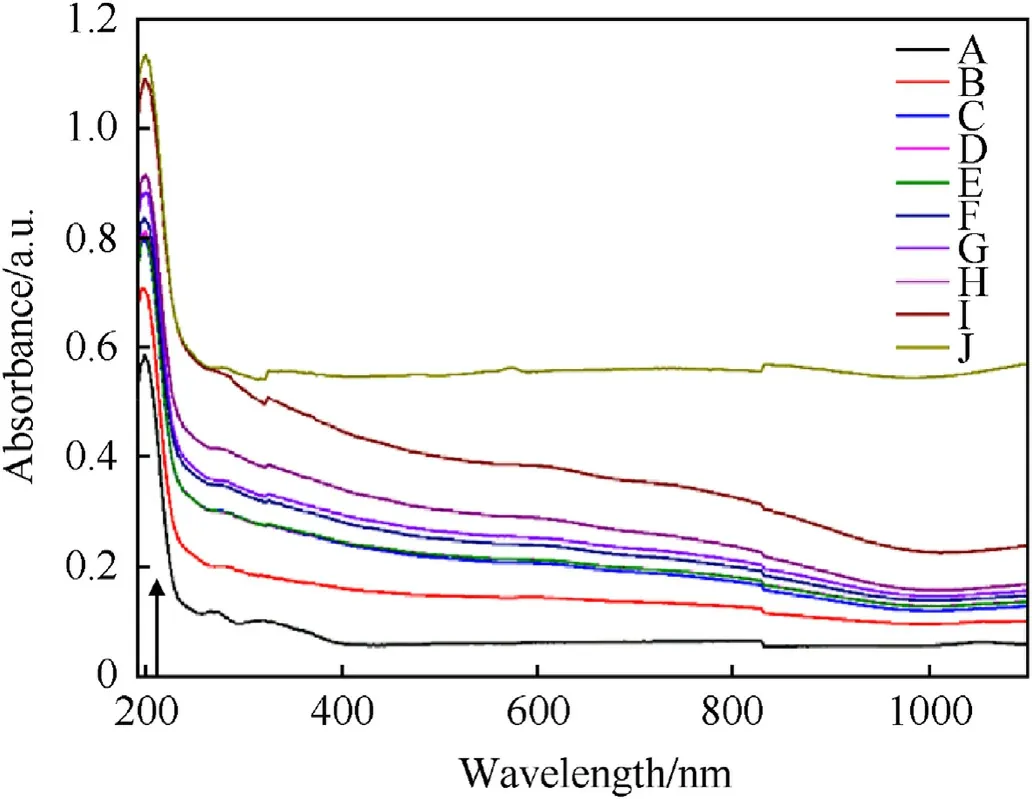
Fig.5.UV curves of samples with different dispersity of nano-CuCr2O4 under the same content (2 wt%).A: Ultrafine AP; B: CuCr2O4-S1; C: CuCr2O4-S2; D: CuCr2O4-S3; E:CuCr2O4-S4; F: CuCr2O4-S5; G: CuCr2O4-S6: H: CuCr2O4-S7; I: CuCr2O4-S9; J:CuCr2O4 (The data of each curve is the average value of three parallel experiments.).
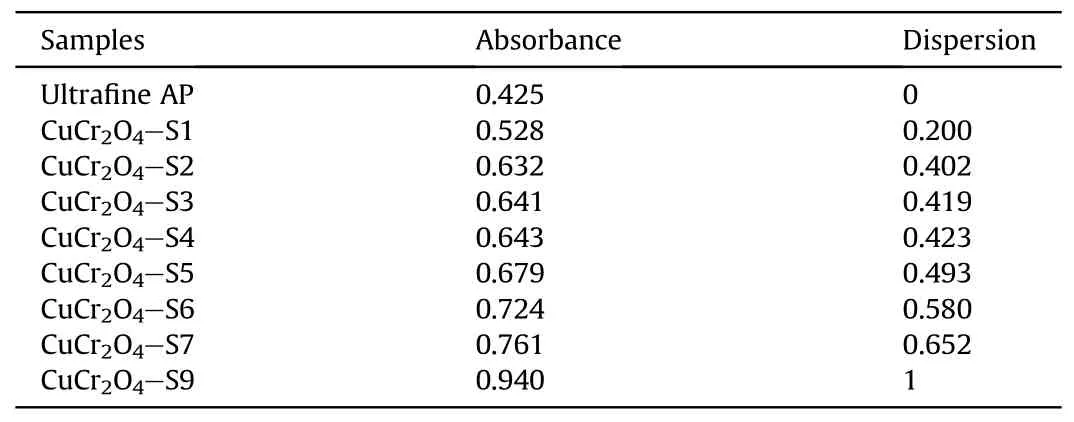
Table 3 The absorbance and dispersion of different samples.
3.2.2.3.Qualitative analysis of the dispersity of samples with different nano-CuCr2O4contents.Three parallel experiments were carried out on ultrafine AP, nano-CuCr2O4and the composites with different contents of nano-CuCr2O4, and the average values were taken to explore the effect of different nano-CuCr2O4contents on the absorbance.The results are displayed in Fig.6.As can be observed in Fig.6, the UV curves of the composites with different nano-CuCr2O4contents are between that of ultrafine AP and nano-CuCr2O4.The UV curves of the composites are closer to the that of nano-CuCr2O4as the nano-CuCr2O4increases.However, the absorbance at 212 nm of different composites changed little with the increase of nano-CuCr2O, this is to say, the dispersity of nano-CuCr2O4in the composite prepared by mechanical grinding for 3 h is close to the optimal dispersity, and the absorbance of the composites at 212 nm cannot be significantly improved even if the content of nano-CuCr2O4was increased.
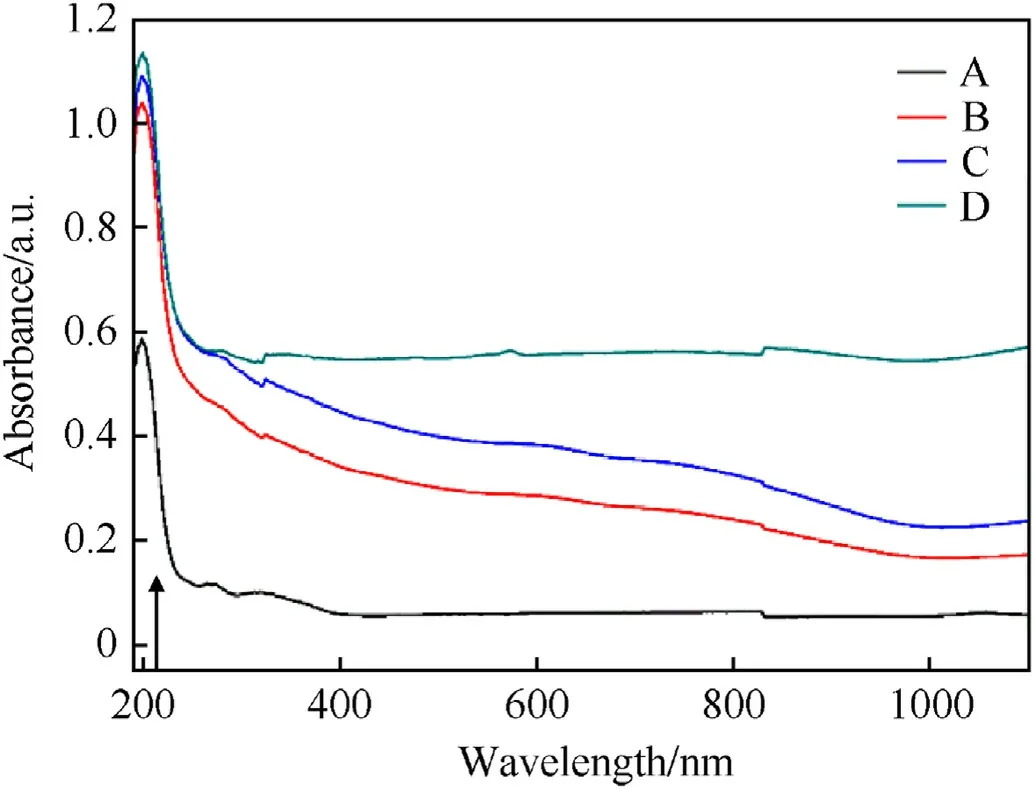
Fig.6.UV curves of samples with different contents of nano-CuCr2O4.A:Ultrafine AP;B: CuCr2O4-S9; C: CuCr2O4-S10; D: Nano-CuCr2O4.
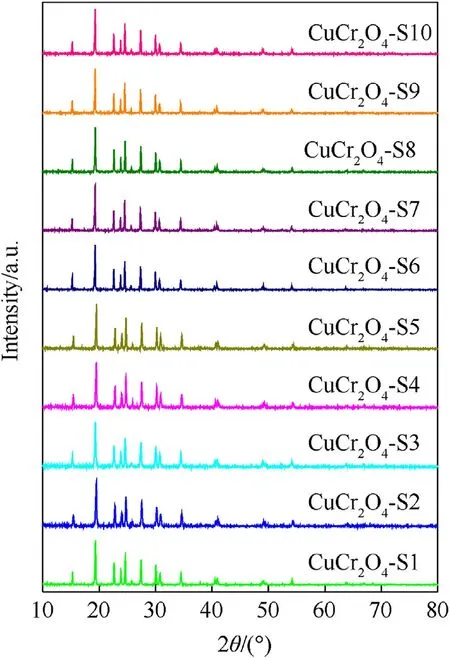
Fig.8.XRD patterns of different nano-CuCr2O4/ultrafine AP composites.
3.2.2.4.Verification of the characterization method for the dispersity of nano-CuCr2O4.The composite(CuCr2O4-S8,the content of nano-CuCr2O4is 2 wt%)prepared by mechanical grinding for 30 min was performed on UV test to further verify the reliability of the method for characterizing the dispersity of nanoparticles by solid UV analysis,and the results are shown in Fig.7.As can be seen in Fig.7,the UV curve of CuCr2O4-S8 is between that of CuCr2O4-S7 and CuCr2O4-S9, indicating that the dispersity of nano-CuCr2O4in CuCr2O4-S8 is between the two samples.In addition, the absorbance of CuCr2O4-S8 at 212 nm is 0.883.It can be concluded that the dispersion uniformity of CuCr2O4-S8 is 0.71 according to Eq.

Fig.7.UV curves of different samples.A:Ultrafine AP;B:CuCr2O4-S1;C:CuCr2O4-S2;D: CuCr2O4-S3; E: CuCr2O4-S4; F: CuCr2O4-S5; G: CuCr2O4-S6; H: CuCr2O4-S7; I:CuCr2O4-S8; J: CuCr2O4-S9; K: CuCr2O4.
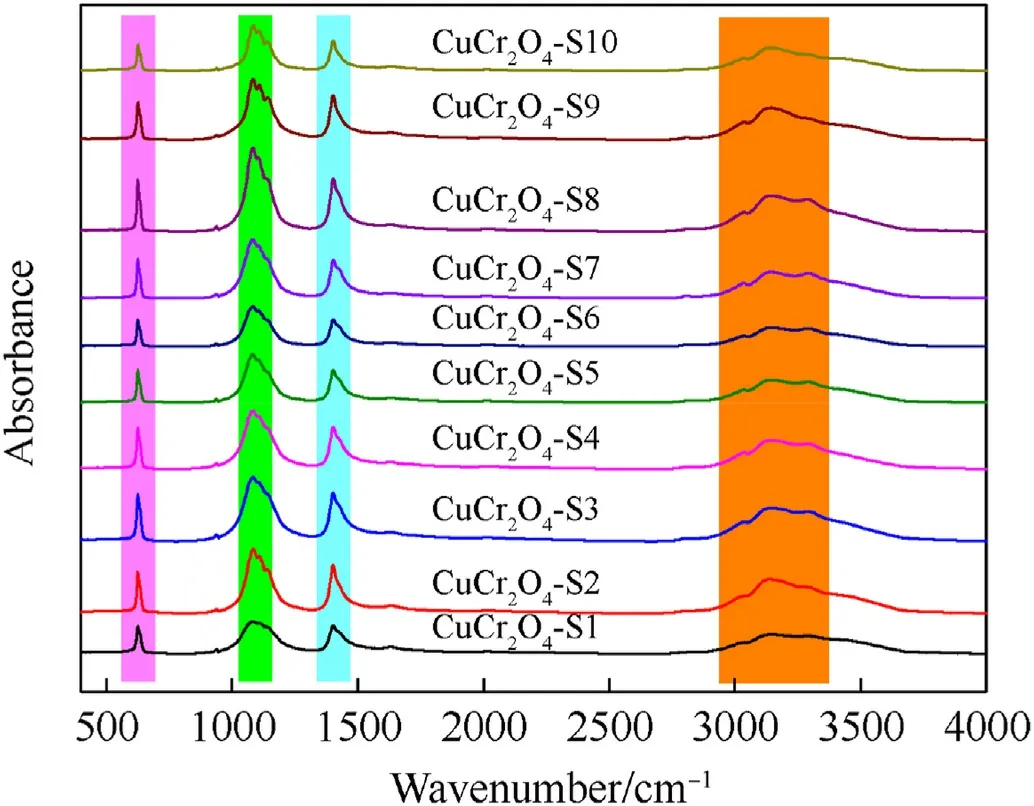
Fig.9.IR spectrum of different nano-CuCr2O4/ultrafine AP composites.
(2),which is between that of CuCr2O4-S7(0.652)and CuCr2O4-S9(1).The above conclusions are consistent with the expected results,which further confirms the accuracy and scientificity of using UV-Vis diffuse reflectance spectroscopy to characterize the dispersity of nano-CuCr2O4in ultrafine AP.
3.3.Characterization of different nano-CuCr2O4/ultrafine AP composites

Fig.10.SEM images of different composites:(a)CuCr2O4-S1;(b)CuCr2O4-S2;(c)CuCr2O4-S3;(d)CuCr2O4-S4;(e)CuCr2O4-S5;(f)CuCr2O4-S6;(g)CuCr2O4-S7;(h)CuCr2O4-S8;(i) CuCr2O4-S9; (j) CuCr2O4-S10.
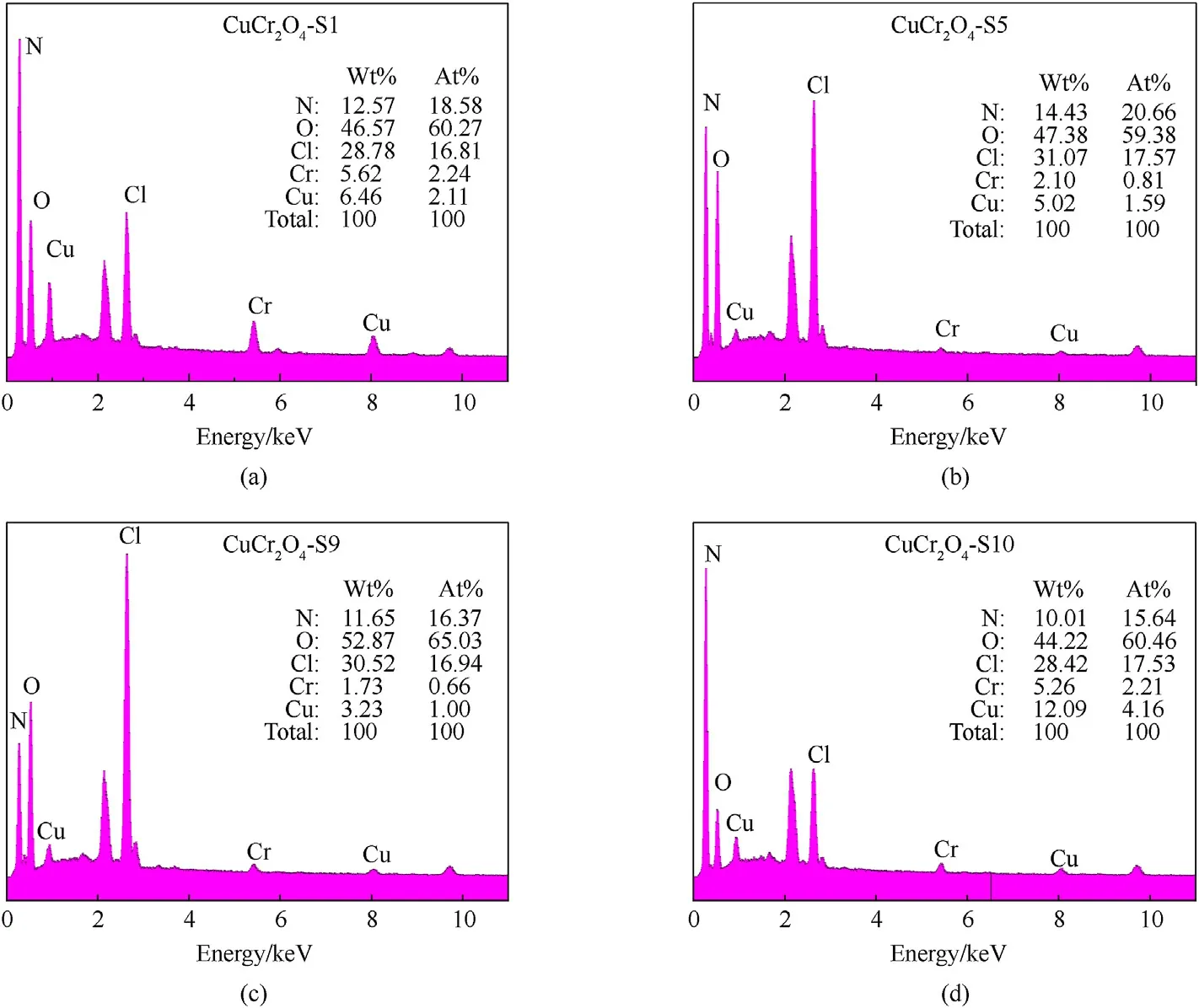
Fig.11.EDS spectra of different samples.
The composites with different dispersity of nano-CuCr2O4were explored with XRD,and the results are presented in Fig.8.As can be observed in Fig.8, the characteristic peaks of the composites prepared by manual grinding and mechanical grinding are consistent with those of ultrafine AP,indicating that the crystal structure and particle size of ultrafine AP did not change during the preparation of the composites, and ultrafine AP also did not react with nano-CuCr2O4.It should be noted that the characteristic peaks of nano-CuCr2O4were not detected in the composites, which is related to the less content of nano-CuCr2O4.The above conclusions illustrate the limitations of the XRD technique in characterizing the dispersity of nanomaterials, and it also demonstrate the necessity of exploring new techniques for characterizing dispersity of nanomaterials [9-11,43].
The different composites were also detected with IR analysis,and the results are shown in Fig.9.Fig.9 shows that four distinct diffraction peaks appear in all different nano-CuCr2O4/ultrafine AP composites.For different composites, the stretching vibration peaks at 619 cm-1and 1030 cm-1are related to ClO4-in ultrafine AP,while the bending vibration peak and stretching vibration peak of N-H bond are located at 1410 cm-1and 3270 cm-1, respectively[44].Obviously, no characteristic peak of nano-CuCr2O4was detected in the composites, which is an undesirable result.The above conclusion is not favorable for us to find the pattern of the dispersion of nano-CuCr2O4in ultrafine AP with the variation of diffraction peaks in IR patterns, which means that the variation of diffraction peaks in IR tests cannot be used to detect the dispersion uniformity of nano-CuCr2O4in ultrafine AP.The IR findings indicate that the structure of the ultrafine AP was not changed during the preparation of the composites and the results are consistent with the XRD, it also shows the urgency of probing new means to characterize the dispersibility of nanomaterials.
Micromorphology analysis through SEM is also a common method to qualitatively characterize the dispersion of nanomaterials.The composites prepared by manual grinding and mechanical grinding were also tested by SEM to explore the dispersity of nano-CuCr2O4in composites, and the results are shown in Fig.10.As displayed in Fig.10,the larger particles are ultrafine AP,while the smaller particles are nano-CuCr2O4.It also shows that the dispersity of nano-CuCr2O4in ultrafine AP improves with increasing grinding time and grinding force.Obviously, the nano-CuCr2O4was uniformly dispersed on the surface of ultrafine AP after mechanical grinding for 3h,and its dispersity was significantly improved.In addition, it can be found that the use of mechanical grinding instead of manual grinding results in better dispersity of nano-CuCr2O4.The above conclusions are consistent with the results of the UV curves, which further confirms the feasibility of using the solid UV absorbance to assess the dispersity of nanomaterials [9-11,42,46,47].
Four composites with different dispersion of nano-CuCr2O4were selected for elemental analysis, and the elements of the samples are shown in Fig.11.As shown in Fig.11,it shows that the different composites all contains the elements of N,O,Cl,Cr and Cu,which confirming the formation of ultrafine AP/nano-CuCr2O4composites.Furthermore, the mapping was conducted to further investigate the distribution of different elements in the samples,and the results are displayed in Fig.12.Fig.12(a)clearly shows that the distribution of Cl, N and O in CuCr2O4-1, which is contained in the ultrafine AP.However, only small amounts of Cr and Cu were detected in the mapping of CuCr2O4-1.That is to say, the stirring method cannot mix the ultrafine AP with nano-CuCr2O4uniformly.As shown in Fig.12(b)-12(d), the dispersion of the different elements in the composites increased with increasing grinding intensity and grinding time, as the different elements can be observed at different positions in the picture,especially the Cr and Cu.The nano-CuCr2O4in CuCr2O4-S9 has the best dispersion with the same content,and the Cr and Cu elements are clearly observed in the mapping of CuCr2O4-S9.The above findings further demonstrate that the dispersion of nano-CuCr2O4increased with increasing grinding intensity and grinding time,and it also confirm the reliability of using solid-UV to probe the dispersion of nanocatalysts in ultrafine AP.It is worth considering that the increase of nano-CuCr2O4under the same preparation conditions hardly changed its elemental dispersion (e.g.CuCr2O4-S9 and CuCr2O4-S10), which is consistent with the results of solid UV[11,20,21].
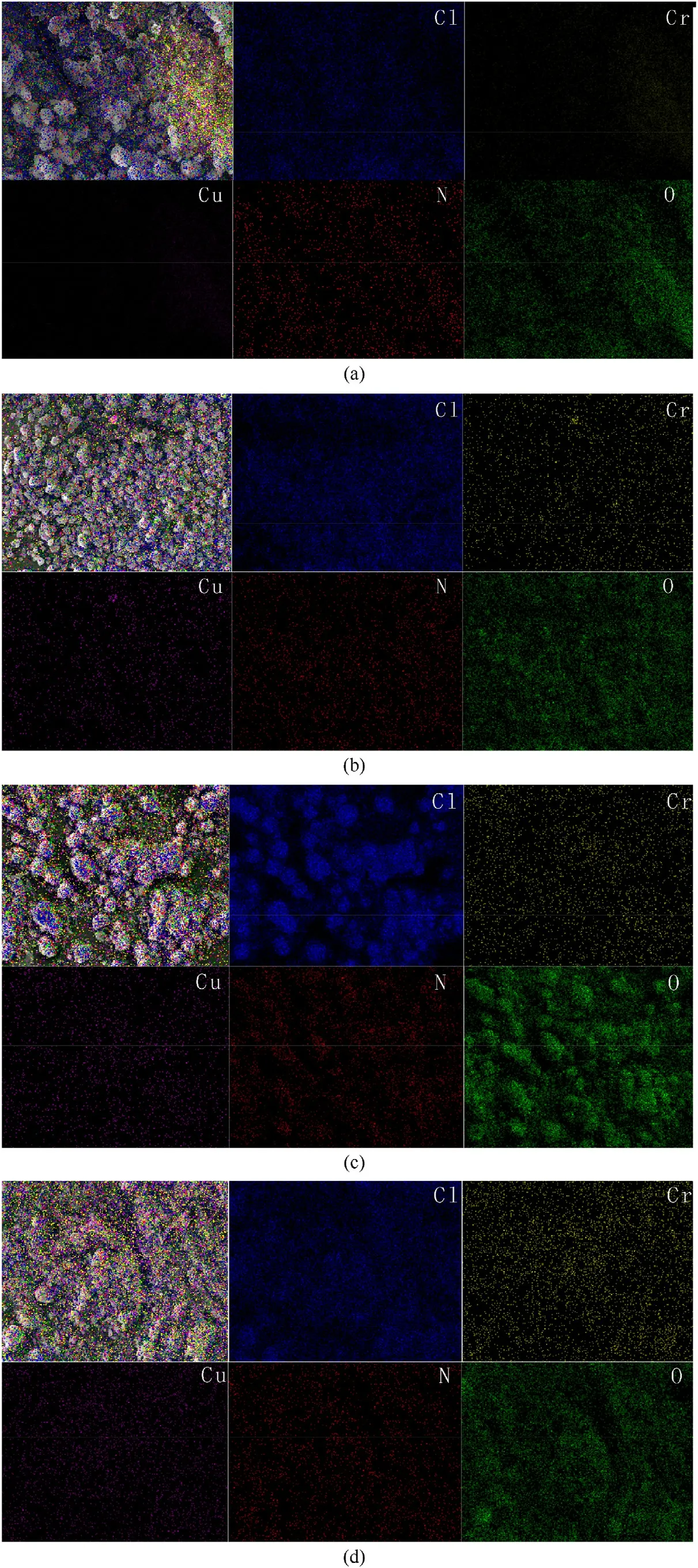
Fig.12.Mapping of different samples: (a) CuCr2O4-S1; (b) CuCr2O4-S5; (c) CuCr2O4-S9; (d) CuCr2O4-S10.
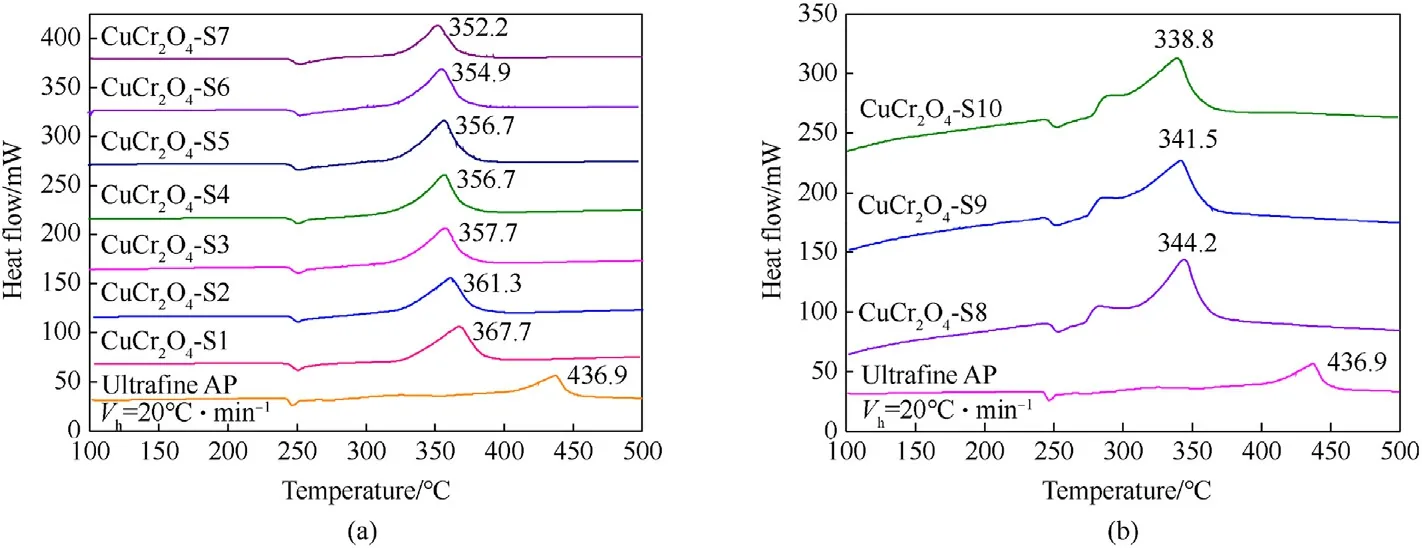
Fig.13.DSC curves of different composites: (a) Manually milled samples; (b) Mechanically grinding samples.
DSC tests were carried out on different samples to explore the effect of nano-CuCr2O4dispersity on the thermal decomposition performance of ultrafine AP, and the results are demonstrated in Fig.13.Fig.13(a) shows that the thermal decomposition temperature of the composites decreases gradually with the increase of grinding strength and grinding time, and the thermal decomposition temperature of the composites is significantly lower than that of ultrafine AP.It also shows that the increased dispersity of nano-CuCr2O4is beneficial to improve its catalytic performance.Especially,the nano-CuCr2O4/ultrafine AP composite obtained under the condition of manual grinding for 60 min reduced the thermal decomposition temperature of ultrafine AP by 84.7°C,showing the obvious catalytic effect of nano-CuCr2O4.Fig.13(b) shows that the thermal decomposition temperature of the composites prepared by mechanical grinding method is lower than that of the composites prepared by manual grinding,indicating that the use of mechanical grinding to prepare the composites is beneficial to the exertion of the catalytic properties of nano-CuCr2O4, which is related to the improved dispersity of nano-CuCr2O4.In addition, the increase of nano-CuCr2O4also reduces the thermal decomposition temperature of the composites [9-11,43,45].
The thermal decomposition of ultrafine AP and CuCr2O4-S9 were also explored with TG-MS to investigate the catalytic effect of nano-CuCr2O4on ultrafine AP, and the results are displayed in Fig.14.Figs.14(a)and 14(b)show the TG and DTG curves during the thermal decomposition of ultrafine AP and CuCr2O4-S9.It clearly shows that the thermal decomposition process of AP and CuCr2O4-S9 all has two stages.Obviously, the thermal decomposition temperature of CuCr2O4-S9 is significantly lower than that of ultrafine AP with the presence of nano-CuCr2O4,and the time from the beginning of decomposition to the end of decomposition is significantly shortened.That is to say,nano-CuCr2O4induces more concentrated exotherm of ultrafine AP,which is more beneficial to improve the energy performance of AP-based propellant.The above conclusion can also be verified by the higher peak values in the DTG curves of CuCr2O4-S9.Moreover, the variation of ion current intensity during the thermal decomposition for different samples is shown in Figs.14(c)-14(f).For ultrafine AP and composites(CuCr2O4-S9), the substances detected were NH3(m/z = 17), H2O(m/z = 18), NO (m/z = 30), O2(m/z = 32), HCl (m/z = 36, 38), N2O
(m/z=44),NO2(m/z=46),ClO(m/z=51),ClO2(m/z=69),Cl2(m/z = 70, 72, 74) and other ion flow fragments.The ultrafine AP exhibits two thermal decomposition stages, which are consistent with the results of TG-DTG, involving a low-temperature decomposition stage and a high-temperature decomposition stage.The thermal decomposition process of AP is extremely complex,involving coupled reactions in the solid,adsorption and gas phase,and the thermal decomposition mechanism of AP has not been fully understood so far.The proton transfer mechanism proposed by Jacobs has been supported by most scholars[48,49].Firstly,during the low temperature decomposition of AP, the protons are transferred from NH4+to HClO4-, resulting in the formation of gaseous NH3and HClO4,and the generated NH3and HClO4would adsorb on the surface of AP to prevent its further decomposition.Then, the proton combines with ClO3-to form unstable HClO3,which is easily decomposed into ClO2,etc.As an intermediate product with strong oxidizing power, ClO2would disappear after oxidizing NH3and NH4+.The low temperature decomposition process can be described as Eq.(3).
The second decomposition stage in the proton transfer theory is mainly the gas phase decomposition on the surface of AP.It includes secondary reactions between the thermal decomposition products of NH3and HClO4, which ultimately produced H2O, NO,O2, HCl, N2O, NO2, Cl2, etc.The reaction process is described in Eq.(4).
It is well known that the nano-CuCr2O4with spinel structure contains more catalytic active sites, which can significantly accelerate the thermal decomposition of AP.Figs.14(e)and 14(f)clearly shows that the formation times of different substances in CuCr2O4-S9 are significantly advanced in the presence of nano-CuCr2O4, which reflects its excellent catalytic performance.The excellent catalytic performance of nano-CuCr2O4is also attributed to its large specific surface area and high reactivity,which facilitates the transfer of protons and promotes the thermal decomposition process of ultrafine AP.
3.4.Inherent law of nano-CuCr2O4 dispersity and its catalytic performance
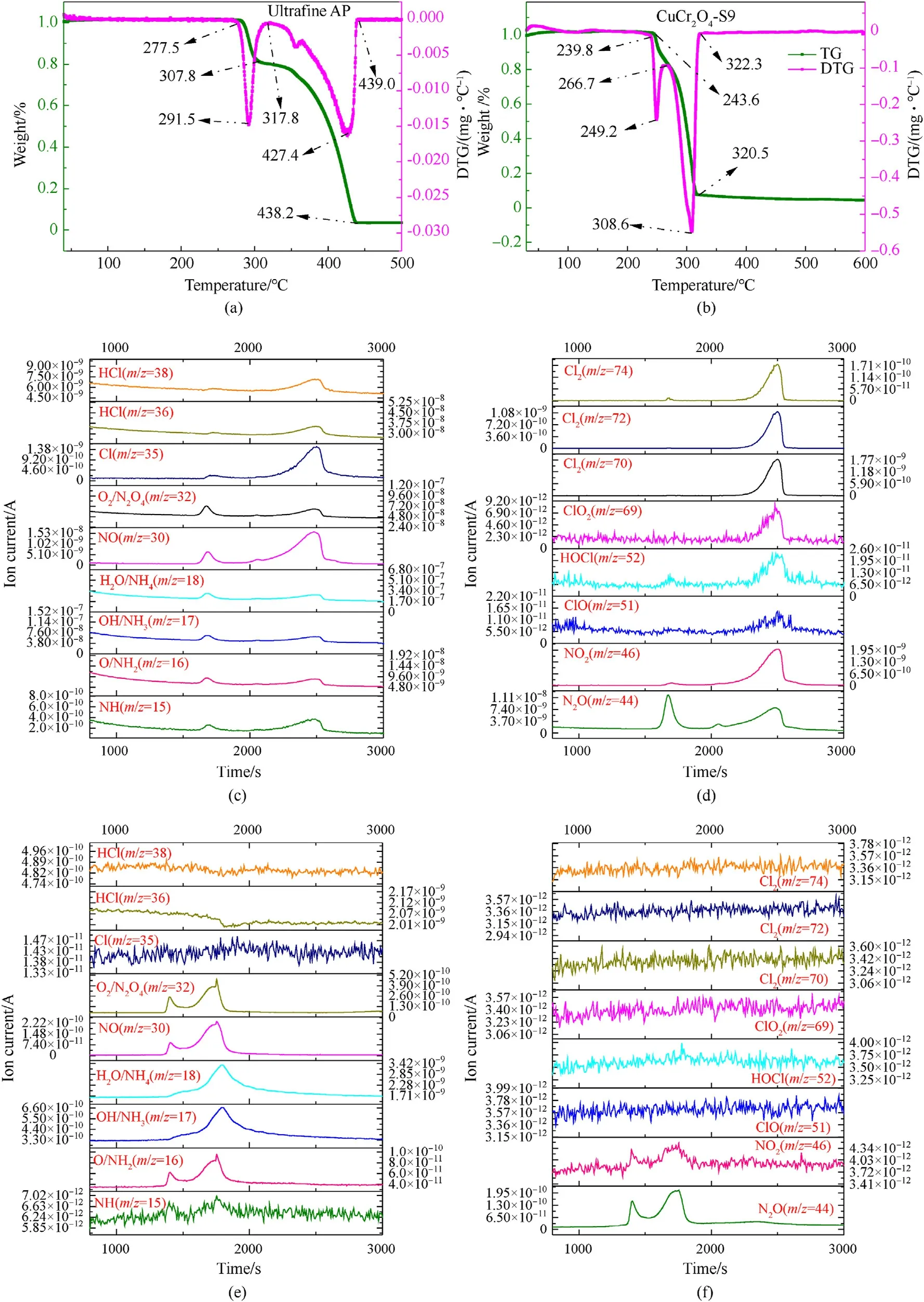
Fig.14.The TG-MS spectra of decomposition products of ultrafine AP and CuCr2O4-S9: (a) TG and DTG curves of ultrafine AP; (b) TG and DTG curves of CuCr2O4-S9; (c), (d) MS spectra of ultrafine AP; (e), (f) MS spectra of CuCr2O4-S9.
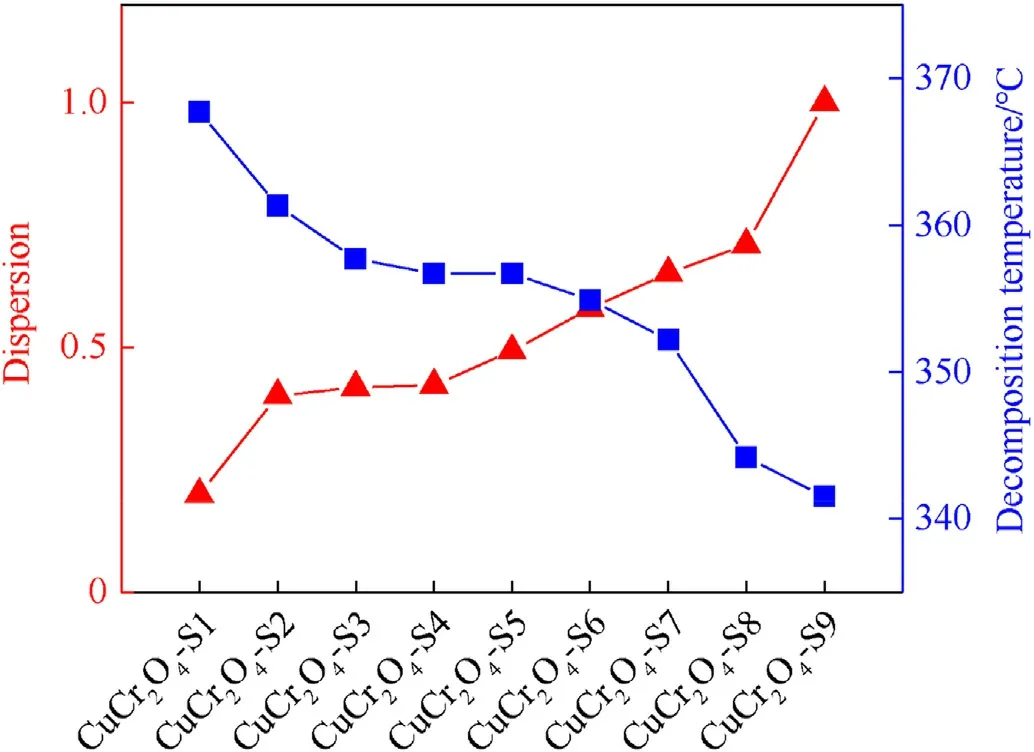
Fig.15.Intrinsic relationship between thermal decomposition temperature and the dispersity of nano-CuCr2O4 in different composites.
The relationship between the dispersity of nano-CuCr2O4and its catalytic performance was further investigated,and the results are shown in Fig.15.As can be seen in Fig.15, the dispersity of nano-CuCr2O4in the composites increased gradually with the increase of grinding strength and grinding time,and the composites prepared by mechanical grinding showed good dispersity of nano-CuCr2O4.The thermal decomposition temperature of the composites decreases with the increasing dispersity of nano-CuCr2O4.The above phenomenon shows that the dispersity of nano-CuCr2O4in ultrafine AP is positively correlated with its catalytic performance, that is to say,the nano-CuCr2O4with good dispersity has better catalytic performance for ultrafine AP, which significantly reduces the thermal decomposition temperature of the composites.
4.Conclusions
In this study, nano-CuCr2O4/ultrafine AP composites with different nano-CuCr2O4dispersion were prepared using different mixing conditions.And then,a new method for characterizing the dispersion of nanomaterials using solid UV curves was proposed,and the corresponding difference equations were established,which breaks the dilemma of not being able to quantitatively analyze the dispersion of nanomaterials.The established difference equation quantifies the dispersion of nano-CuCr2O4, which facilitates the investigation of the intrinsic relationship between the dispersion of nanomaterials and their catalytic performance.SEM and EDS techniques were used to investigate the dispersion of nano-CuCr2O4in ultrafine AP, and it shows that the dispersion of nano-CuCr2O4increased with the increase of grinding time and grinding intensity,which is consistent with the results of solid UV.The results of XRD and IR tests show that the particle size of the raw materials did not change during the preparation of the composites,and there was no chemical reaction between nano-CuCr2O4and ultrafine AP that causes the formation and disappearance of chemical bonds or chemical groups.That is to say, no additional factors occurred during the preparation of the composites to interfere with the accuracy of the solid UV tests.We also found that the thermal decomposition temperature of the composites decreased with the increase of the defined dispersity, which intuitively illustrates the intrinsic relationship between the dispersity and catalytic performance of nanomaterials.These satisfactory conclusions demonstrate the innovativeness and feasibility of our self-developed method for characterizing the dispersity of nanocatalytic materials, which is expected to be widely used and provide a new idea for researchers in the follow-up research.For example, we could explore the dispersity of nano-catalytic materials (nano-CuO, nano-Fe2O3, nano-TiO2, nano-MnO2, nano-NiO,etc.) in EMs (RDX, HMX, AN, ADN, CL-20, etc.), and further investigate the interrelationship between the dispersity of nanocatalytic materials and their catalytic properties using solid UV method, so as to promote development in the field of EMs.
Declaration of competing interest
The authors declare that they have no known competing financial interests or personal relationships that could have appeared to influence the work reported in this paper.
Acknowledgements
This work was financially supported by the National Natural Science Foundation of China (Project Nos.21805139, 21905023,12102194,22005144 and 22005145),the Joint Funds of the National Natural Science Foundation of China(Grant No.U2141202),Natural Science Foundation of Jiangsu Province (Grant No.BK20200471),the Fundamental Research Funds for the Central Universities(Grant Nos.30920041106, 30921011203), and Young Elite Scientists Sponsorship Program by CAST(Program, 2021QNRC001).
Appendix A.Supplementary data
Supplementary data to this article can be found online at https://doi.org/10.1016/j.dt.2023.04.004.
- Defence Technology的其它文章
- Mussel-inspired PTW@PDA composites for developing high-energy gun propellants with reduced erosion and enhanced mechanical strength
- An intelligent control method based on artificial neural network for numerical flight simulation of the basic finner projectile with pitching maneuver
- Shock Initiation Experiments with Modeling on a DNAN Based Melt-Cast Insensitive Explosive
- Coupling effect on the thermal hazard assessment of hazardous chemical materials via calorimetric technologies and simulation approaches
- Process and performance of DAAF microspheres prepared by continuous integration from synthesis to spherical coating based on microfluidic system
- TransTM: A device-free method based on time-streaming multiscale transformer for human activity recognition

